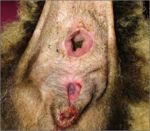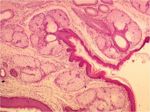Anus - Anatomy & Physiology
Jump to navigation
Jump to search
BACK TO ALIMENTARY - ANATOMY & PHYSIOLOGY
BACK TO LARGE INTESTINE - ANATOMY & PHYSIOLOGY
Introduction
Structure
Function
Vasculature
Innervation
Lymphatics
Histology
- At the anus, the columnar intestinal epithelium is replaced by the stratified squamous keratinised epithelium of the skin.
- As the muscosa changes from columnar to cutaneous, three zones are created:
- Columnar
- Has many longitudinal folds.
- Divided from the rectum by the anorectal line.
- This is a line where the mucosa is stratified squamous epithelium containing lots of lymphoid tissue.
- Intermediate
- Divided from the cutaneous zone by the anocutaneous line.
- Cutaneous
- Skin.
- Stratified squamous keratinised epithelium.
- Surrounds the anus.
- Excretory ducts of the anal sacs open into this region.
- Large, coiled apocrine tubules.
- Have many glands in their walls.
- These glands are tubuloalveolar and produce a fatty secretion.
- Anal sacs are clinically important as they are commonly diseased in dogs - frequently, they become enlarged due to accumulated secretion.
- Columnar

